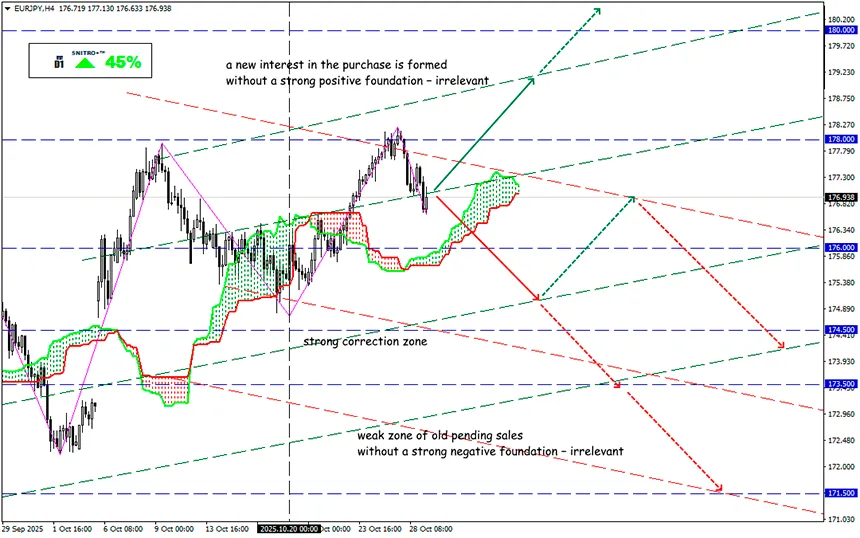Labor Market or Inflation: What Matters More to the Fed?

EUR/JPY
Key zone: 176.50 - 177.50
Buy: 178.00 (on strong positive fundamentals) ; target 179.50-180.00; StopLoss 177.50
Sell: 176.00 (on a pullback after correction to 176.80) ; target 174.50; StopLoss 176.50
Monetary policy is a constant balancing act — a choice between short-term stability and long-term risks.
The Federal Reserve’s task is to control inflation and ensure maximum employment — and today, both vectors of this dual mandate are moving in opposite directions. For example, everything that stimulates demand benefits the labor market, but those same measures push prices higher.
Today, the Fed is expected to cut the federal funds rate by 25 basis points — the second time in 2025. The goal is clear: to support the labor market, which is increasingly losing momentum.
Lowering the rate will stimulate pre-holiday spending, increase consumer activity, and allow businesses to pass part of the tariff-related costs onto consumers.
However, the downside of this strategy is obvious: cheap credit accelerates inflation. If rates remain high, companies will hire more cautiously, and job growth will slow.
According to Bloomberg, initial jobless claims for the week ending October 11 dropped to 215,000 from 234,000 the week before — a temporary relief amid turbulence.
The partial government shutdown complicates the publication of official statistics. According to the Partnership for Public Service, about 900,000 federal employees have been furloughed without pay, and another 700,000 continue working without pay. Some states allow these workers to receive unemployment benefits, but payments must be repaid once funding is restored.
If the White House succeeds in pushing through its mass layoff plan, unemployment could surge catastrophically. A few months without work is an unaffordable luxury for most Americans — 37% have no savings for unexpected expenses over $500.
Fears that tariffs will again fuel inflation have temporarily faded from the agenda. However, uncertainty due to tariff threats and the shutdown makes it harder for the Fed to make decisions — seven of nineteen FOMC members saw no reason to cut rates this year. Still, long-term forecasts (not updated today) suggest one more rate cut before year-end.
If the Fed’s independence is questioned, the interest rate ceases to be a financial instrument and becomes a political one — a symbol of trust in the American financial model.
In fact, the Fed has left the door open in both directions — and the market heard it.
For Powell, maintaining balance in his reasoning is extremely difficult now. Any wrong move could lead to a loss of market confidence.
On the one hand, dovish rhetoric supports the economy; on the other, it undermines confidence in the Fed’s independence. The dollar and Treasury bonds risk losing their role as cornerstone assets of the global system.
Today, the market does not expect the Fed to give clear signals regarding future policy. Powell will try to preserve multiple policy options and avoid making specific commitments until the end of the year.
So we act wisely and avoid unnecessary risks.
Profits to y’all!

















